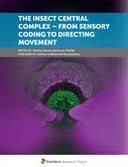Explore

The Insect Central Complex – From Sensory Coding to Directing Movement
Stanley Heinze and Keram Pfeiffer
2018
0 Ungluers have
Faved this Work
Login to Fave
The most fundamental function of the brain is the analysis and integration of sensory information in order to generate motor commands that result in directed, meaningful interactions with the environment. This process can be viewed as an internal comparison between the current state of the world and a desired state of the world, with any mismatch leading to compensatory action. For an animal to respond to external stimuli in a directed way in any given sensory situation, it first has to assess the orientation of its body with reference to the environment. The current body position computed in this way then has to be matched against the desired position, and any resulting discrepancy has to be compensated for by a change in limb position, movement direction, or a transition to a new movement mode. The desired body orientation depends on many different parameters, such as the animal’s nutritional state, its reproductive status, the time of day, the current behavioral state, or previous experience. Vertebrate brains process these parameters across diverse brain regions, involving millions of neurons, a fact that makes pinpointing the underlying circuitry a daunting endeavor.Across insects, a single brain area, the central complex, is involved in many of the mentioned fundamental processes: It contains an ordered array of head direction cells, its neurons are targeted by multisensory input pathways, visual and spatial memories reside in this region, and certain central-complex neurons are active just before movements of the animal, predicting its future turning direction. Additionally, state-dependent changes of neural response characteristics and a vast supply of neuromodulators suggests a highly dynamic, context-dependent remodeling of local circuitry. All of this places the central complex at the interface of sensory processing and motor planning, providing a location at which current and desired heading could be compared and adequate action can be selected in response. The highly regular, almost crystalline neuroarchitecture of this region has the advantage of enabling us to immediately connect structure with function - at the level of identified, individual neurons. The neural algorithms implemented in the circuitry that mediate action selection are thus uniquely accessible in this brain region. This research topic therefore aims at connecting the diverse aspects of central-complex function and develop an open-source framework in which to embed current knowledge (reviews) and novel findings from biological, theoretical, and engineering perspectives (original research articles, short communications). Four complementary sub-topics provide the main focus: 1) The current state of the world - Encoding and integration of sensory information; 2) Generating behavior - Motor planning and neural correlates of behavior; 3) Computing the desired state of the world - Integration of internal state, memory, and behavioral state; 4) Neural hardware and algorithms - The underlying circuits and computations of the central complex. By illuminating structure-function relations on multiple levels in diverse species, within a brain region that is omnipresent across insects, we aim at exposing fundamental principles that enable animals to generate adaptive behavior despite inhabiting a world of an infinite number of possible sensory scenarios.
This book is included in DOAB.
Why read this book? Have your say.
You must be logged in to comment.
Rights Information
Are you the author or publisher of this work? If so, you can claim it as yours by registering as an Unglue.it rights holder.Downloads
This work has been downloaded 276 times via unglue.it ebook links.
- 82 - mobi (CC BY) at Unglue.it.
- 113 - epub (CC BY) at Unglue.it.
- 81 - pdf (CC BY) at Unglue.it.
Keywords
- action selection
- Central Complex
- Insects
- motor control
- neural circuits
- Neuroanatomy
- Neurobiology
- sensory integration
Links
DOI: 10.3389/978-2-88945-578-2Editions

